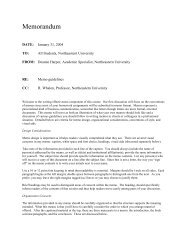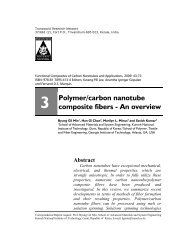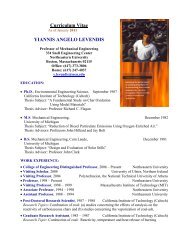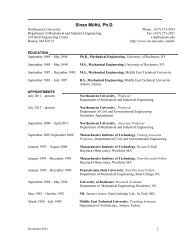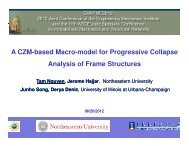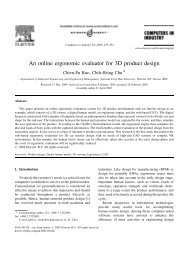Create successful ePaper yourself
Turn your PDF publications into a flip-book with our unique Google optimized e-Paper software.
206 L. Pallarés, J.F. <strong>Hajjar</strong> / Journal of Constructional Steel Research 66 (2010) 198–212<br />
(Fig. 5a, b, g) <strong>and</strong> the specified (nominal) material strengths (Fig. 5c,<br />
d, e, f) are used in the formulas for both steel <strong>and</strong> concrete<br />
failures so as to provide an indication of the test-to-predicted<br />
values using nominal values typical in design calculations. AWS<br />
D1.1/D1.1:2006 Structural Welding Code—Steel [55] specifies two<br />
types of headed stud, type A <strong>and</strong> type B, for use in composite<br />
systems depending on their function within the structure. The<br />
main difference between them is the ultimate tensile strength of<br />
the headed stud. Type A [Fu = 61 ksi (420 MPa)] are generalpurpose<br />
headed studs of any type <strong>and</strong> size used for purposes other<br />
than shear transfer in composite beam design <strong>and</strong> construction.<br />
Type B [Fu = 65 ksi (450 MPa)] are studs that are headed, bent,<br />
or of other configuration, with diameter of 3/8 in (9.5 mm), 1/2<br />
in (12.5 mm), 5/8 in (16 mm), 3/4 in (19 mm), 7/8 in (22 mm) or 1<br />
in (25 mm), <strong>and</strong> that are used commonly in composite beam design<br />
<strong>and</strong> construction. The AISC [30] commentary provides steel anchor<br />
material specifications that include specified (nominal) yield <strong>and</strong><br />
tensile strengths of typical ASTM A108 [56] Type B studs as 51 ksi<br />
(350 MPa) <strong>and</strong> 65 ksi (450 MPa), respectively (AWS 2004).<br />
ACI 301-08 [57] provides formulas for the average measured<br />
concrete (f ′<br />
cr ) strength given the specified (nominal) concrete<br />
strength (f ′<br />
′ ′<br />
c ); for example, f cr = f c + 1200 (in psi), for a<br />
specified (nominal) concrete strength between 3000 <strong>and</strong> 5000 psi.<br />
In Fig. 5, the stud strength has then been computed using the<br />
Fig. 4. Concrete failure formulas in comparison with concrete failure in tests.<br />
specified concrete strength derived from the average measured<br />
concrete strength reported in the test. An important conclusion<br />
from this figure is that if hef /d is restricted to being larger than<br />
4.5 (or, comparably, h/d is restricted to being larger than 5), using<br />
the steel formula alone is adequate to safely predict the shear<br />
strengths of the studs. Even those tests that fail in the concrete are<br />
generally seen to have test-to-predicted ratios larger than 1, with<br />
little difference from the case where both the steel <strong>and</strong> concrete<br />
formulas are checked, <strong>and</strong> the minimum used (as seen in Fig. 5(d)<br />
<strong>and</strong> (f)). In Fig. 5(c) <strong>and</strong> (e), using only the steel formula with<br />
specified (nominal) strength values results in test-to-predicted<br />
ratios of 1.964 for studs with Fu of 51 ksi (350 MPa) <strong>and</strong> 1.541 for<br />
studs with Fu of 65 ksi (450 MPa), based on using 0.65AsFu as the<br />
design strength of the headed stud failing in shear.<br />
Fig. 6 plots the test-to-predicted ratios for all tests using the<br />
minimum of the steel strength (0.65AsFu) <strong>and</strong> concrete strength<br />
formulas for several different concrete strength formulas. The<br />
figure compares steel (•) <strong>and</strong> concrete (×) formula predictions,<br />
distinguishing type of failure in the top of each figure (C.F. means<br />
concrete failure, M.F. means mixed failure, <strong>and</strong> no mark means<br />
steel failure). It may be seen that the concrete formula always<br />
controls the strength prediction for hef /d < 4.5, which is<br />
commensurate with the type of failure (concrete failure or mixed<br />
failure) found in most of those tests. In contrast, the concrete



